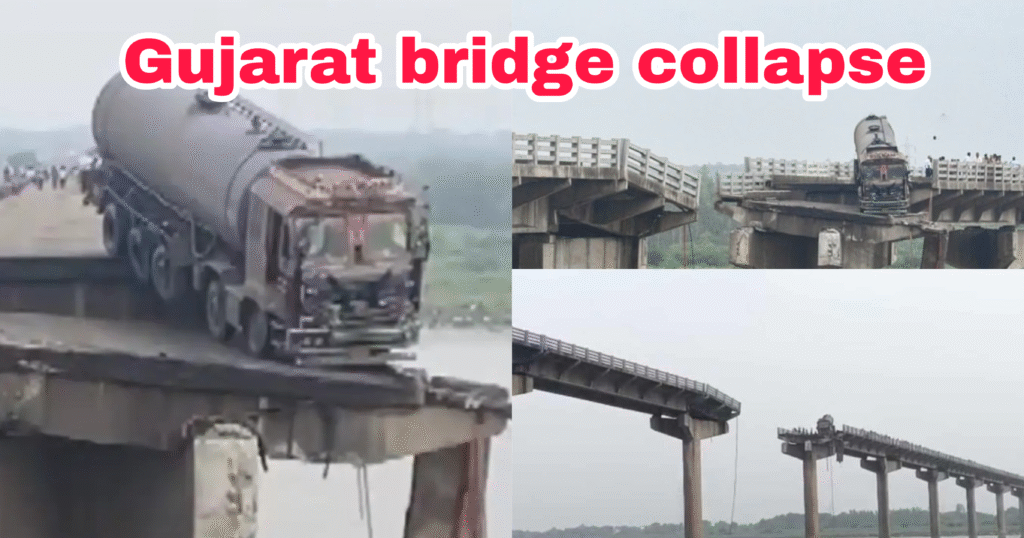
On the morning of July 9, 2025, a tragic incident unfolded in Gujarat’s Vadodara district, when the Gambhira Bridge, a vital link between rural and urban regions, collapsed unexpectedly, plunging multiple vehicles into the Mahisagar (Mahi) River. The bridge collapse occurred near Padra Taluka, shocking residents and raising serious questions about the condition of India’s aging infrastructure.
🚑 Death Toll and Rescue Operations
- Casualties: 10 people have been confirmed dead.
- Injuries: Several others were injured, some critically, and are being treated at local hospitals.
- Vehicles involved: Two trucks, an SUV, and a van were among those that fell into the river.
- Rescue: NDRF (National Disaster Response Force), SDRF, fire personnel, and police teams rushed to the spot. Local residents also played a key role in early rescue efforts.
Eyewitnesses said the bridge collapsed suddenly without warning. “There was a loud sound, and the entire section just vanished. We saw vehicles plunge into the river,” said a local shopkeeper.
🛤️ History of the Gambhira Bridge
Built in 1985, the Gambhira Bridge had served as a crucial connector in Vadodara’s transport network. Constructed with reinforced cement concrete (RCC) technology, it was designed for lighter vehicular movement compared to today’s load-heavy traffic.
Bridge Highlights:
- Location: Over the Mahisagar River, Padra Taluka
- Span: Approx. 160–200 meters
- Age: 40 years old
- Purpose: Connected agricultural towns with industrial hubs in Vadodara
- Maintenance status: Last major inspection reportedly occurred in 2018
Over the past few years, locals had raised concerns about visible cracks, vibrations during heavy movement, and weak railing structures. However, no major restoration or strengthening project was undertaken despite repeated warnings.
🌧️ What Caused the Collapse?
Preliminary investigations have identified multiple contributing factors:
⚠️ Primary Reasons:
- Aging Structure: The bridge, constructed in the 1980s, was well beyond its optimal lifespan without any significant retrofitting.
- Monsoon Impact: Recent heavy rainfall led to rising river levels and high water velocity, possibly weakening the base supports.
- Overloaded Vehicles: The bridge was not designed to handle modern multi-axle trucks and high-tonnage traffic.
- Lack of Timely Repairs: Despite visible signs of damage, no urgent action was taken by authorities to repair or reinforce the structure.
Experts believe the foundation and supporting piers may have suffered erosion (scouring) over the years due to continuous water flow, weakening the base and ultimately leading to the structure giving way.
🇮🇳 Government Response: Compensation and Inquiry
The tragedy sparked immediate reactions from both state and central authorities:
- Prime Minister Narendra Modi expressed deep sorrow and announced ₹2 lakh compensation for families of the deceased and ₹50,000 for the injured.
- Chief Minister Bhupendra Patel ordered a high-level investigation and asked for a detailed report within a week.
- The Vadodara Municipal Corporation and State Road & Building Department have initiated a structural audit of other old bridges in the region.
A criminal investigation may also be launched to determine if any official negligence played a role.
🔙 Morbi Bridge Collapse 2022: Are We Repeating Mistakes?
This isn’t the first major bridge tragedy in Gujarat. In October 2022, the Morbi suspension bridge over the Machchhu River collapsed, killing 135 people. That bridge had been reopened after repairs without proper certification. The event shocked the nation and led to arrests of company officials and civic engineers.
The recent Gambhira Bridge collapse shows that lessons from Morbi may not have been fully learned. The common factors in both cases—old bridges, ignored warnings, improper audits—underline a systemic problem in how we handle infrastructure.
📊 The Bigger Picture: Bridge Safety in India
India has over 1.6 lakh registered bridges, many built during the pre-liberalization era. According to a 2023 report by the Indian Bridge Management System (IBMS):
- 23% of India’s bridges are functionally obsolete
- 12% are structurally deficient
- Only 38% of bridges receive regular inspection reports
States like Gujarat, Maharashtra, and Bihar have a high density of overaged rural and semi-urban bridges, many of which are at risk during monsoon.
🧠 Expert Opinion: What Needs to Be Done
Dr. Mehul Shah, Structural Engineering Expert from CEPT University, Ahmedabad, says:
“The collapse is an outcome of delayed maintenance, poor risk evaluation, and outdated load standards. India needs to invest in predictive analytics and AI-based monitoring for bridges. Waiting for damage to become visible is no longer an option.”
🛠️ Future Roadmap: Preventing the Next Collapse
To prevent more such tragedies, experts recommend the following steps:
✅ Recommendations:
- Mandatory Audits: Conduct audits every 2–3 years for all bridges over 20 years old.
- Digital Monitoring: Install real-time vibration and load sensors on key bridges.
- Public Reporting Channels: Allow citizens to report early signs of damage via mobile apps.
- Bridge Management Authority: Set up a centralized body for bridge inspections and certifications.
- AI & Drone Surveys: Use drone technology and AI to detect micro-cracks and stress fractures invisible to the human eye.
📣 Final Thoughts: Safety Cannot Wait
The Gujarat bridge collapse is not just a regional disaster—it is a national wake-up call. Lives are being lost not due to natural disasters, but because of avoidable human errors, poor planning, and institutional neglect.